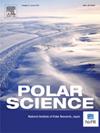Thaw slump development and other rapid permafrost disturbances in Hollendardalen Valley, Svalbard
IF 1.5
4区 地球科学
Q3 ECOLOGY
引用次数: 0
Abstract
From 2019 to 2022, for the first time in Svalbard, the rapid development of a thaw slump was observed in Hollendardalen Valley (Nordenskiöld Land, West Spitsbergen), affecting an area of 6300 m2. Fast-paced thermokarst and thermo-erosion processes exposed massive ground ice, as well as thick ground ice veins within frozen silt strata. In the riverbed – in a non-carbonate, non-karstifying geological setting – thaw funnels appeared, swallowing part of the river flow, presumably via a local fault zone connecting to deep aquifers. The exposed ground ice has extremely low mineralization, dominated by Na+ and SO42− ions. The properties and morphology of the ice veins point to segregation origins. The broad middle reaches of the Hollendardalen Valley exhibit thermokarst depressions and lakes, tabular terrace remnants and traces of past thaw slumping. Such morphology represents a thermo-erosional plain, formed through the interplay of fluvial erosion and a series of fast-paced thermo-erosion and thermokarst events. The very presence of massive ground ice in places where its appearance was previously unexpected indicates the possibility of detecting further ground ice of various thicknesses in Svalbard. Thus, ongoing and future permafrost warming will likely accelerate rapid permafrost thaw in Svalbard, reshaping the surface morphology and subsurface hydrology.
斯瓦尔巴群岛霍伦达达伦山谷的融化滑坡发展和其他快速的永久冻土扰动
从2019年到2022年,斯瓦尔巴群岛首次在Hollendardalen山谷(Nordenskiöld Land,西斯匹次卑尔根岛)观察到融化滑坡的快速发展,影响了6300平方米的面积。快节奏的热岩溶和热侵蚀过程暴露了大量的地下冰,以及冻结粉土地层中厚的地下冰脉。在河床上,在非碳酸盐、非岩溶地质环境中,出现了融化漏斗,可能是通过连接深层含水层的局部断裂带,吞噬了部分河水。地表冰矿化程度极低,以Na+和SO42−离子为主。冰脉的性质和形态表明了分离的起源。广阔的霍伦达达伦河谷中游地区有热岩溶洼地和湖泊、板状阶地遗迹和过去融化滑坡的痕迹。这种形态代表了一个热侵蚀平原,是由河流侵蚀和一系列快节奏的热侵蚀和热岩溶事件相互作用而形成的。在以前意想不到的地方出现了大量的地面冰,这表明在斯瓦尔巴群岛有可能探测到更多不同厚度的地面冰。因此,持续和未来的永久冻土变暖可能会加速斯瓦尔巴群岛永久冻土的快速融化,重塑地表形态和地下水文。
本文章由计算机程序翻译,如有差异,请以英文原文为准。
求助全文
约1分钟内获得全文
求助全文
来源期刊

Polar Science
ECOLOGY-GEOSCIENCES, MULTIDISCIPLINARY
CiteScore
3.90
自引率
5.60%
发文量
46
期刊介绍:
Polar Science is an international, peer-reviewed quarterly journal. It is dedicated to publishing original research articles for sciences relating to the polar regions of the Earth and other planets. Polar Science aims to cover 15 disciplines which are listed below; they cover most aspects of physical sciences, geosciences and life sciences, together with engineering and social sciences. Articles should attract the interest of broad polar science communities, and not be limited to the interests of those who work under specific research subjects. Polar Science also has an Open Archive whereby published articles are made freely available from ScienceDirect after an embargo period of 24 months from the date of publication.
- Space and upper atmosphere physics
- Atmospheric science/climatology
- Glaciology
- Oceanography/sea ice studies
- Geology/petrology
- Solid earth geophysics/seismology
- Marine Earth science
- Geomorphology/Cenozoic-Quaternary geology
- Meteoritics
- Terrestrial biology
- Marine biology
- Animal ecology
- Environment
- Polar Engineering
- Humanities and social sciences.
 求助内容:
求助内容: 应助结果提醒方式:
应助结果提醒方式:


